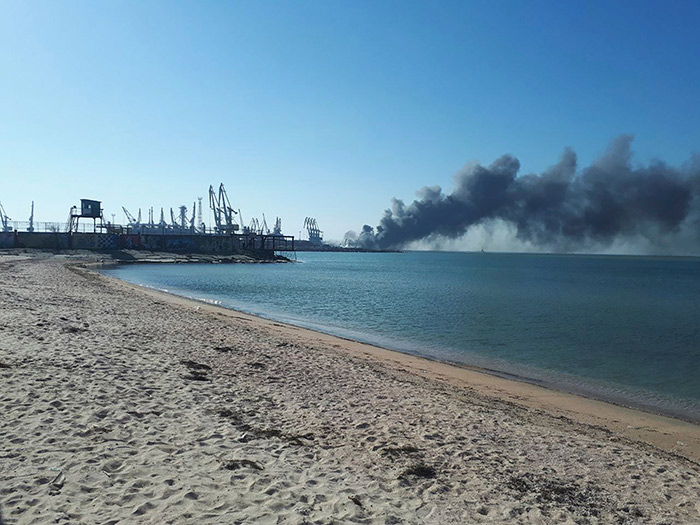By Grant Anderson
April 27, 2022
On April 13th, 2022, a stunning development transpired in the Russia-Ukraine conflict –the Russian guided-missile cruiser Moskva was sunk by Ukraine. The Moskva – named after Russia’s capital of Moscow – was the flagship of the Black Sea Fleet (which itself has historically been the pride fleet of the Russian Navy). The ship sustained initial damage on April 13th – and the vessel sunk while under tow back to the Russian port at Sevastopol the next day. Russia continues to claim that the ship was lost due to an accidental fire and ordnance explosions, but U.S. officials are supporting the Ukrainian claim that two Ukrainian-built Neptune missiles struck Moskva about 60 miles from Odesa.

Russia has been tight-lipped about the loss of the Moskva, but the blow to everything from Russian military morale to operational planning and posture has to be considerable. At the same time, the symbolic victory for Ukraine in sinking the pride of the Black Sea Fleet has to be immense. The Moskva was the biggest Russian naval asset to be sunk in action since WWII, and likely the largest warship sunk in combat since the Falklands War in 1982.
But beyond the Moskva itself, and the impact of her loss on the war, there are some wider takeaways. Broadly speaking, every military conflict presents an ability to learn. And as Russia’s war on Ukraine continues to play out in real-time, we are presented with new windows through which to view the capabilities, doctrine and tactics of the belligerent and defending powers. Everything that is occurring in the conflict theater presents a case study, or a warning, or something useful to consider moving forward. And in this regard, the sinking of the Moskva presents a number of real learning opportunities.
Simply put, the destruction of the Moskva is a bold reminder that naval warfare is alive and well – a fact that the U.S. and our allies need to come to real terms with now and into future years. The Moskva is actually the second major ship to be sunk in the Ukraine conflict; the Russian ship Berdyansk was sunk in late March. In fact, the number of warships from across the globe – from the U.S. to the United Kingdom, to Russia, and other NATO forces – currently operating in European waters is considerable. In late March, Russia not only had some 22 ships in the Black Sea, but another 13 surface warships operating in the eastern Mediterranean.
Moreover, the sinking of the Moskva should be raising a litany of questions – not just about the Russian Navy, but those of China – and our own naval capabilities and defenses as well. On the one hand, the Moskva incident clearly shows that you don’t need a hypersonic missile to destroy a major warship (though the Neptune missile was designed for use against ships up to a certain displacement size – as are many missile systems). On the other, it only reinforces the real and quickly advancing threat to surface ships from modern, and increasingly sophisticated missile technologies. And for this reason – while we need to have enough ships in our arsenal in order to address our interests abroad – warships absolutely must be at the cutting edge of technological capability, in everything from defensive systems and armaments, to signals detection and electronic warfare technologies, to power generation.
In the Fiscal Year 2023 federal budget, released by the White House in late March, $180.5 billion is requested for the entire U.S. Navy, from procurement to operations & maintenance, to military personnel, to development & research (the Marine Corps budget for FY23 is another $50.4 billion – for a total Navy Dept. request of $230.8 billion). The amount is more than was requested in President Biden’s FY22 budget, and it prioritizes the development of new ship classes (such as the Columbia class submarine).
This is all a good thing, though we are still well short of reaching the Congressionally-mandated mark of a 355 ship Navy – and this budget funds what is basically an amount still under 300 ships (the FY23 budget decommissions a lot of ships, even while funding the procurement of new vessels). Without question, we need more warships. America is a maritime nation with long coastlines and distributed responsibilities around the world reliant on sea access and power. Our economy relies on access to the world’s sea lanes. And we have an existential interest in ensuring access to, and maintaining protection of, the global maritime commons. There is strength in numbers. And so the effort to rebuild our naval fleet is vital – and in the process, we revitalize American shipbuilding, which is of great economic and industrial benefit at home.
That said, we also need to remain committed to the other part of naval advancement – the high technology and research side. While the FY23 Navy budget asks for $21 billion for research & development – again, it is an amount greater than the last budget cycle – it is a figure that we will need to build up in the coming years as we compete with China, a nation that seems to be achieving rapid technological and scientific progress in the areas of both defense and space, and one that has its eyes on the island nation of Taiwan, accessible only by sea and air.
All of this is increasingly important as success in the arena of global competition – to prevent conflict, avoid miscalculation, or win a kinetic fight once it ensues – becomes more reliant on speed. The faster a force can preempt or stun the adversary – by reducing the time in accurately understanding the battlefield, by rapidly detecting and identifying threats, and by deploying counter-measures more quickly – the likelier the chance of success. The role of technology in more quickly shaping, comprehending, and navigating the battle-space is incalculable.
As the U.S. Congress turns to the appropriations process for FY23, and as the global security environment is churning in uncertainties, we need to learn every lesson we can from what we see unfolding daily. Policy-makers in Washington also have a great resource in the private sector to stay ahead of the technology curve – scientific development and innovation in our defense tech sector is simply moving too fast to ignore if we want to incorporate the most advanced technology, applications and concepts into our national defense assets.
Like many things to come out of the ongoing Russia-Ukraine conflict, the Moskva incident serves as a key reminder of how fast things can turn on the modern battlefield, and how conventional assumptions can be easily shattered. The sinking of the Moskva clearly shows that naval warfare is not an antiquated concern from a bygone era. We would do well to study it thoroughly as we rebuild our Navy to face the spectrum of maritime security challenges ahead.
Article courtesy of RealClearDefense.com
https://www.realcleardefense.com/articles/2022/04/27/naval_warfare_is_alive_and_well_829287.html
